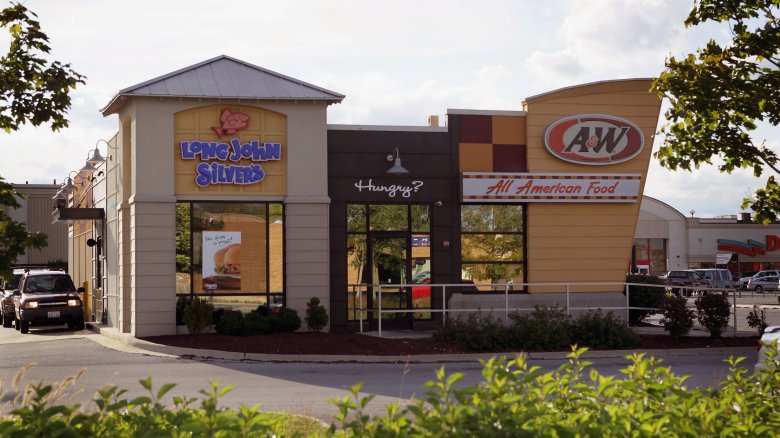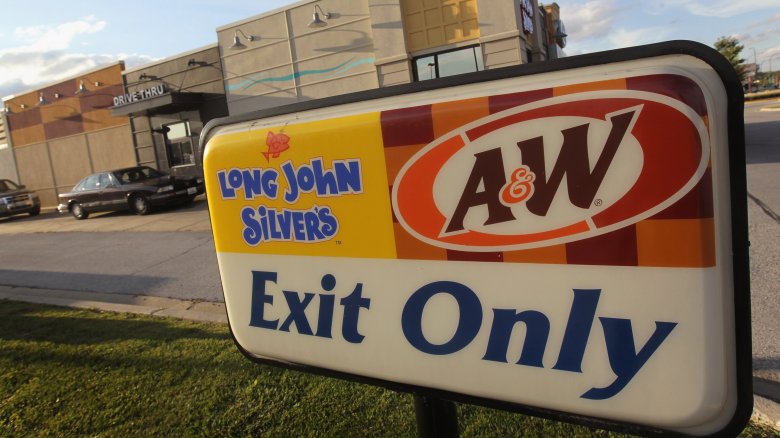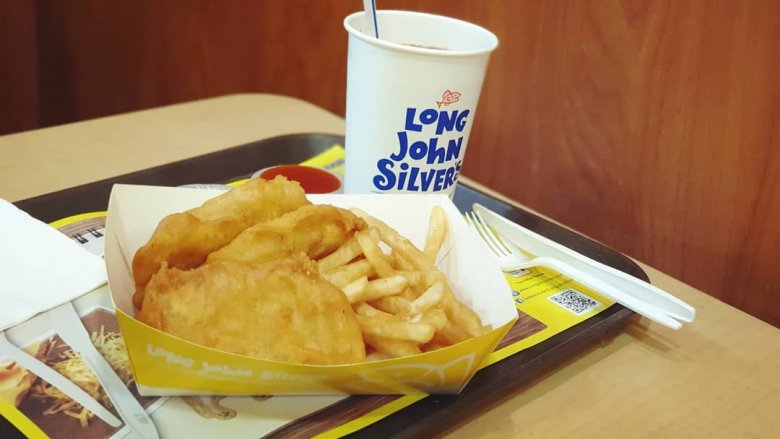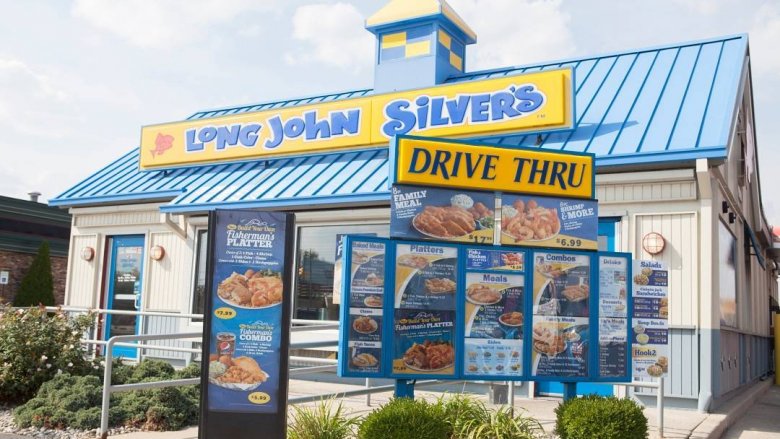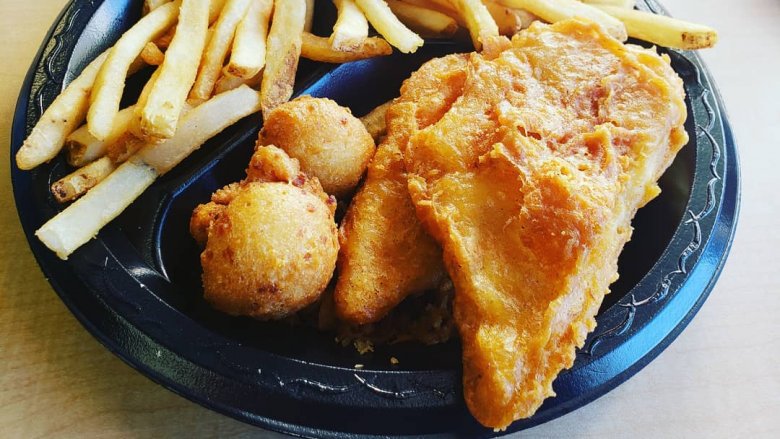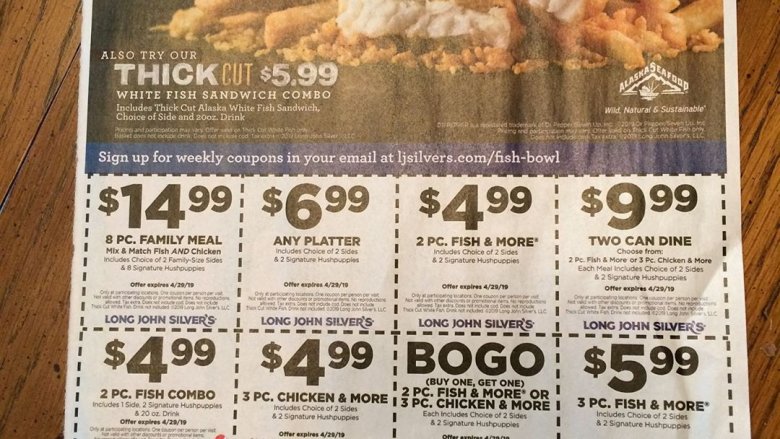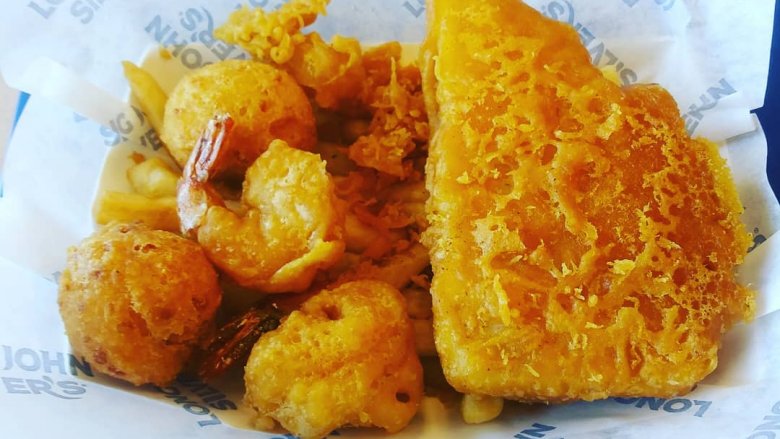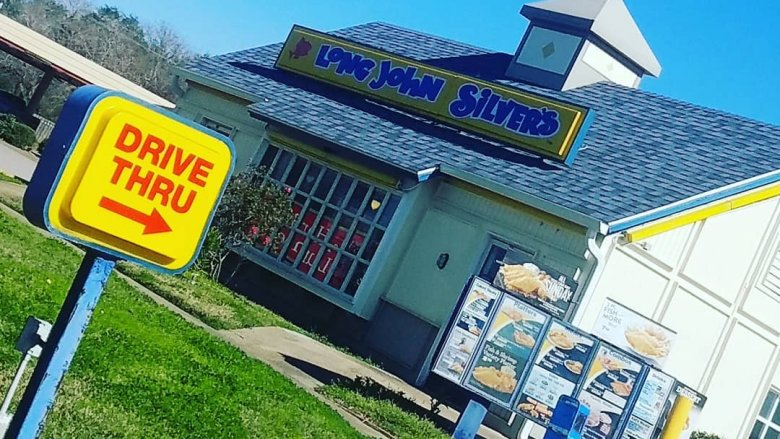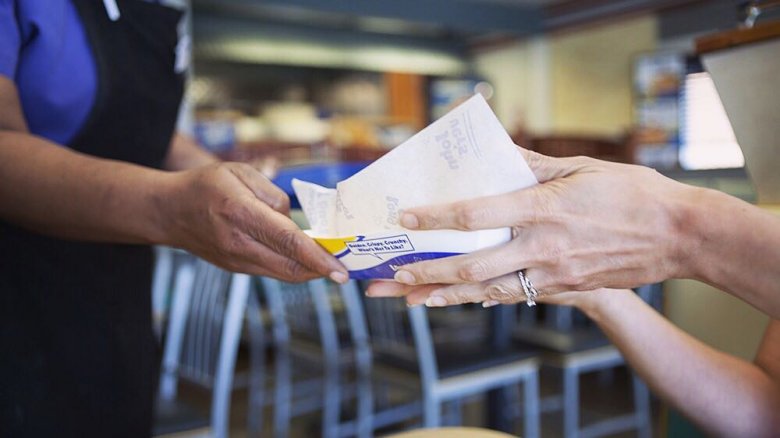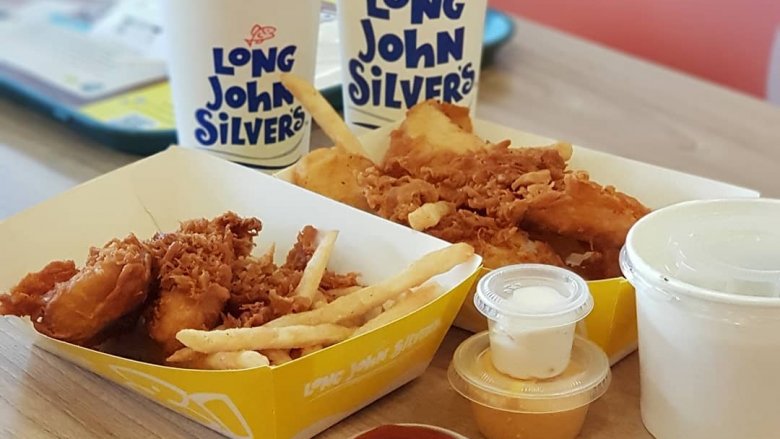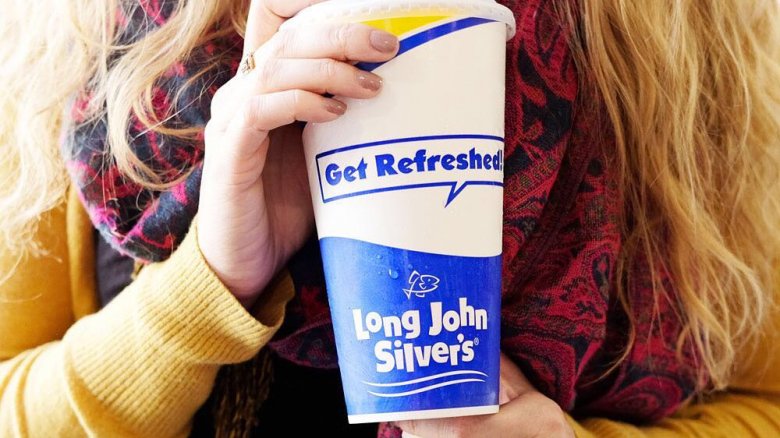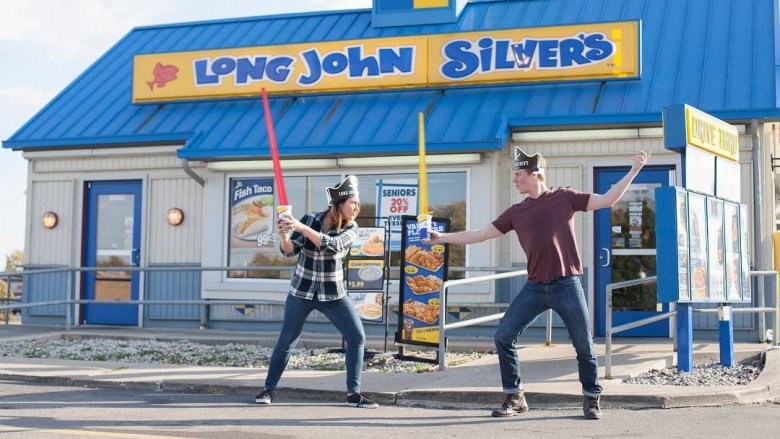The Real Reason Long John Silver's Is Struggling
If there's a cliché about Americans that's known all over the world, it's our seemingly insatiable urge to eat deep-fried platters of bargain-priced fish and chips while hurtling at highway speeds down the road in our cars. Wait, NONE of that is true? Then it's probably therein, Long John Silver's, that our trouble begins.
Founded in Lexington, Kentucky in 1969, the original premise for the chain sounded good, at least on paper. After a trip to a less-landlocked state with his family, businessman and restaurateur Jim Patterson had a flash of inspiration: Bring the sunny seaside fish and chips eating experience to families nationwide, for everyone to enjoy.
Fast forward to the late 1990s and beyond, however, and the chain was in trouble with profits that failed to impress. Most outposts of the restaurant occupied dingy highway rest areas and partially abandoned strip malls in the least desirable neighborhoods, with lawsuits, the threat of bankruptcy, a questionable rebranding effort, and rapidly closing franchise locations, all spelling big problems for the company.
Let's take a look at what went wrong with Long John Silver's, and what they're doing to try to turn the tide of this once-OK quick-service fried seafood institution.
Co-branded restaurants diminish the seafaring experience
Y'know that feeling you get when you have a craving for fried cod, but ALSO kind of want a root beer float? Or how about those times when an order of deep-fried shrimp would hit the spot, but you ALSO kind of want to eat 57 packets of Taco Bell hot sauce? Yeah, we don't get it either.
In a departure from Patterson's original goal of delivering the charm of a seaside lunch to the otherwise landlocked masses, the acquisition of Long John Silver's by A&W in 1999 (which was later acquired by Tricon Global, the company that would eventually become Yum Brands, who also own KFC, Taco Bell, and Pizza Hut) brought with it some changes that drastically impacted the look-and-feel of the stores. Gone were the traditional Cape Code-style blue-roofed buildings, with their wooden tables, pilings, ships' wheels, and assorted nautical bric-a-brac, replaced by generic split locations that often shared space with disparate brands, such as A&W Root Beer.
The overall impact to the dining experience was profound, making it harder for customers to forget that they were actually parked at a highway rest area 2,500 miles from the nearest ocean, instead of at a folksy seaside fish shack.
The food itself is pretty bad
It's hard to mess up an order of deep-fried fish-and-chips, right? After all, if your product is fresh, your batter isn't too weird and thick, and your fryer oil is reasonably clean, the product essentially cooks itself, with little room for human error.
Unfortunately, many Long John Silver's locations seem to have trouble pulling off even this basic trifecta of fried fish excellence. Weird, diamond-shaped slips of fishy-smelling fish, hush puppies that taste like fried wads of bread dough, and so-called "cheese curds" that taste suspiciously like deep-fried chunks of string cheese.
Oh, and then there's the shrimp, described best by Business Insider: "It probably isn't possible to fry up shrimp that you found under the seat of your car while looking for lost change among the dusty grime, but if it was, this is roughly what they would taste like. If we had to find a positive, the breading on these inedible crustacean nuggets was... fine."
With reviews like that, it's no wonder they're not doing great.
The restaurant interiors are badly in need of an upgrade
When the chain first started, Long John Silver's made an effort to impart each location with a seafaring theme reminiscent of the company's vacation-inspired roots. As the restaurants hit a financial low-water mark, however, the uninspired interior design was one of the first areas to suffer. When locations began to split to share space with A&W Root Beer, any notions of atmosphere or charm were thrown directly overboard. Dingy, dark interiors with well-worn plastic booths became the norm, and held all of the appetizing appeal of a neglected gas station bathroom — a place not typically cited for driving the desire to eat seafood.
The company recently began overhauling its stores as part of a brand redesign, beginning with the flagship location in Louisville, Kentucky. The new modern design, unveiled in March 2018, retains the classic blue-and-yellow colors of the original restaurant, updated for modern customers with cutting-edge digital order displays, more sophisticated drive-through technology, and nautical visual cues on the inside referencing the sourcing of the ingredients. Here's hoping those new design elements help transform eating a grubby plate of fried fish into more of a sophisticated culinary experience.
The menu has been slow to change with the times
"Welcome to Long John Silver's. Would you like something fried, twice-fried, or run over by a car and then fried?" Whether you're in the mood for fish, shrimp, chicken, hushpuppies, cheese, or potatoes, if you're eating at Long John Silver's, you're probably eating something deep-fried. This probably felt like enough of an innovation in the late 1960s, when the chain started, and before we all became accustomed to the novelty of eating fried seafood while simultaneously conducting the other everyday business of our lives. But nearly 50 years later, customers are looking for healthier, more interesting mealtime options, and Long John Silver's has been slow to catch up.
A menu overhaul was announced in early 2018, led by new CEO James O'Reilly, though the wheels of progress are turning slowly. In addition to the chain's batter-fried favorites, the new menu will eventually add additional grilled options including salmon and shrimp, griddled fresh and served in a taco or a bowl with rice and coleslaw — because modern fast food customers love eating things out of bowls.
Unfortunately, the introduction of the fresh new menu only happened at 54 restaurants originally, and the requirement of new grills meant other locations were slow to see them realized. After the announcement of his hiring in January 2019, COO Blain Shortreed said he planned to focus on rolling out the new menu to many locations in 2019.
A seafood-based menu makes it hard to undercut competitors on price
Have you noticed how fast food pricing wars tend to erupt from time to time? Burger King will roll out a new burger, and Wendy's fires back with a bigger, better version that costs a dollar less. Dunkin' Donuts introduces a new breakfast sandwich, and McDonald's Egg McMuffins are suddenly priced at two for $2. Taco Bell starts dumping cheese sauce into a gordita, and Del Taco responds by selling you an entire bowl of liquid cheese for a nickel. Because these chains buy ingredients at such inconceivably high volumes, and the margins on their product are so good, the big boys can afford to undercut each other on price whenever the mood strikes.
Not so at Long John Silver's, where margins on seafood are significantly slimmer. And when "fish" is the key component of almost everything you serve, it can be tough to cut prices without cutting portions or quality.
It's not always Lent, when the restaurant is most profitable
No matter how many different ways we squint at the calendar, we can't figure out a way to make it so Lent lasts all year. Which is unfortunate, since it's the time of year that Long John Silver's is at its most profitable.
For the 51 million Catholics in the United States that observe the dietary restrictions of Lent, where members are discouraged from eating red meat on Fridays as a shout out to Jesus and the 40-day fast that led up to his crucifixion, the sudden uptick in nationwide fish consumption translates into big dollar signs for chains like Long John Silver's. In 2017, the chain sold 2 million pounds of seafood during Lent, with the biggest single-day increases in sales occurring on Ash Wednesday and the first Friday of the Lenten season, before forgetful Catholics start to slip up and go back to eating cheeseburgers. On average, Friday sales at Long John Silver's during Lent go up by 84 percent, and the company begins its marketing push six months in advance. If only it could be Lent all of the time.
They've been hammered hard by lawsuits
It can be hard for any company to withstand a flurry of lawsuits, but for a restaurant chain like Long John Silver's, that litigation can be tough to recover from... especially when the CALL IS COMING FROM INSIDE THE HOUSE.
In 2010, a Long John Silver's franchisee filed suit against parent company Yum Brands, alleging that the company "misled" the franchisee in its determination to co-brand his 26 locations with the A&W brand. The lawsuit alleged that the A&W and Long John Silver's co-branding efforts resulted in restaurants that were not as profitable as stand-alone locations, and made cross-promotion between brands next to impossible.
A class action lawsuit alleging unfair labor practices surfaced in 2005, as well as various other smaller-scale disputes between franchisees and the parent company, proving that companies that tie up their resources fighting among themselves in court can't often keep an eye on managing the bottom line.
The balance sheet was a mess, prior to bankruptcy
Something was looking awfully fishy about Long John Silver's balance sheet prior to being granted bankruptcy protection in 1998. The company listed assets totaling just $329 million dollars, with creditors breathing down their necks to collect over $450 million in liabilities. The biggest unsecured creditors included investment firms like Goldman-Sachs, but also marketing firms and inventory suppliers, all of which indicate that the brand was carrying too much debt and operating well outside the limits of its balance sheet.
The company was acquired out of bankruptcy by A&W Brands in 1999, and then passed off to the company that would become Yum Brands, who spent nine years trying unsuccessfully to figure out what to do with the brand before selling it back to an investment group that includes the original founder of the company. The focus of the company is now on rebuilding the empire, while keeping debt more firmly in check.
Customers didn't want to eat The Worst Meal in America
If there was one thing that freaked Americans out in 2013 more than exploding cell phone batteries or the mere existence of Hayden Panettiere, it was our growing suspicion that unhealthy trans fats may be lurking in unexpected places. Or in this case, not SUPER unexpected places, such as the deep-fried seafood apocalypse known as the "Big Catch" at Long John Silver's.
In 2013, the Center for Science in the Public Interest dubbed the "Big Catch," which consisted of battered-and-fried fish, hush puppies, and onion rings "The Worst Meal in America," sporting over 1,300 calories and "more trans fats than you should eat in two weeks." The batter-and-hydrogenated-oil-encrusted meal also clocked in with 19 grams of saturated fat, almost 3,700 milligrams of sodium and 33 grams of trans fats.
In a press release at the time, CSPI executive director Michael F. Jacobson described the meal as, "A heart attack on a hook. Instead of the Big Catch, I'd call it America's Deadliest Catch," proving that some people should stick to chromatically analyzing seafood batter and leave the hilarious cutting-edge fast food commentary to the big dogs.
Efforts to expand overseas have been shaky, at best
If you're already struggling to get customers in the door at your chain of over 1,000 drive-through fried fish joints, expanding your operations by opening a few overseas locations is a no-brainer, right? RIGHT?
As it turns out, the Long John Silver's experience, such as it is, isn't something that necessarily translates well to foreign markets. In Australia, for example, a country with a well-established love for the local fish 'n' chip shop, Long John Silver's and A&W tried to make inroads into the local market with a location on the outskirts of Sydney, which unceremoniously folded within a few years. A liquor store now stands in its place.
The problems that plague Long John Silver's at stateside locations (namely, eating boring, flavorless fried seafood in a generic chain restaurant with little culture or atmosphere of its own and next to no connection to its local environment or the people in it) plague its overseas franchise operations, as well.
A potential sale in 2015 fell apart at the last minute
After closing hundreds of locations and selling and reselling the chain of restaurants several times, Long John Silver's continues to be the problem child of the fast food industry that no one can seem to figure out quite what to do with.
Even the chain's current owners, LJS Partners LLC, which is made of multiple investors and staff that have been with the company since its inception, seem like they'd be happy to unload the business, given half the chance. A sale looked imminent in 2015, after LJS Partners and a Texas-based company called KeyCorp began circling the negotiating table, entering into a preliminary agreement to execute the sale. All of those batted eyelashes and flirtatious glances ended up being for nothing, however, as both companies "mutually agreed to terminate the agreement" at the last minute.
Now, LJS Partners is left holding the company, with no plans to sell "for the foreseeable future." Sounds like it's time for someone to finally figure out how to reignite our national love affair with quick-service fried fish.
